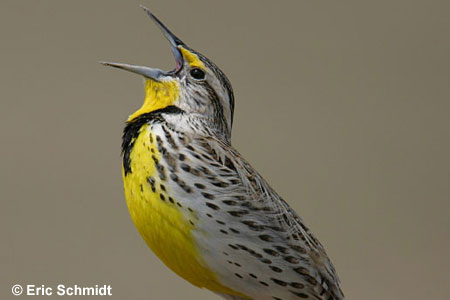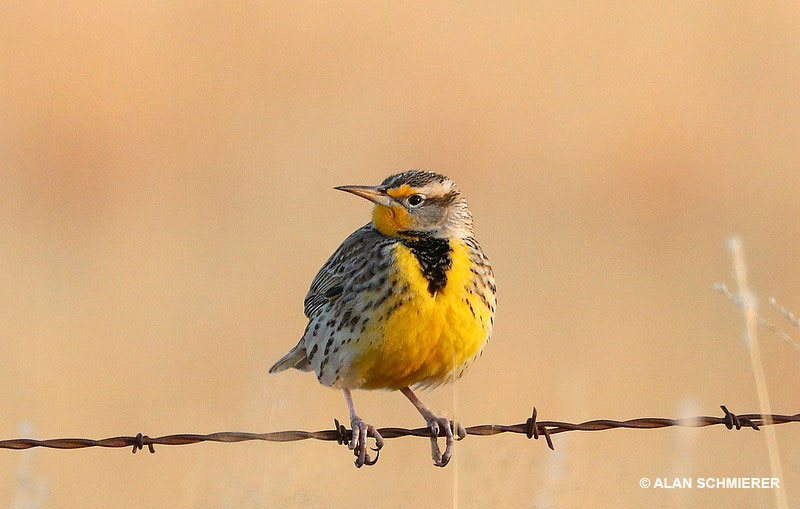The Western Meadowlark is a common bird species of grasslands and other open habitats in much of western North America.
This rotund pale sandy brown bird with long legs and yellow highlights is often seen singing from posts and other perches on roadsides in western states and provinces. They forage for grain, grasshoppers, and other insects while walking in open fields and grasslands, and, in flight, shows white edging to a short tail.
On this page
Identification
The Western Meadowlark is a rather chunky, thrush-sized bird with a fairly long, sharp, blue-gray beak, long, pale pink legs, somewhat rounded wings, and a short square-shaped tail.
Males and females look the same and have a black, “V”-shaped mark on a bright yellow breast. They also have bright yellow on the throat, the lower part of the face, lores (the area on the face in front of the eyes), and most of the underparts. They have dark streaks and markings on white flanks, a long, mostly white eyebrow, a dark line going back from the eye, and dark mottling on a white face.
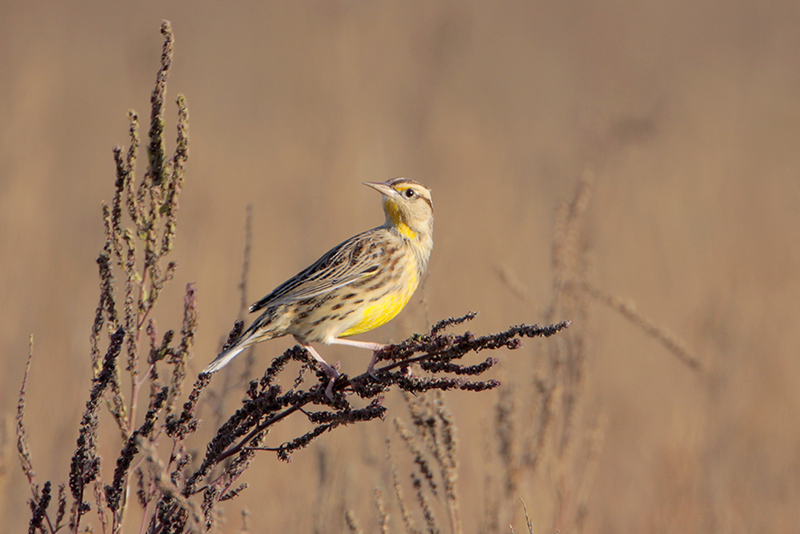
The rest of the upperparts are sandy-brown mottled with dark marks and white edging to the feathers. This mottled pattern and coloration help camouflage the bird from predators in the open, grassy habitats they frequent. When the Western Meadowlark takes flight, it gives a rattling call and shows white on the edge of the tail.
Although both sexes look almost exactly alike, the male is slightly larger and a bit more colorful. Juveniles resemble adults but are paler and have dark streaks on the breast instead of the prominent, black “V” shown by adult birds.
The Western Meadowlark has a quaint, pretty song of brief, flute-like notes that drift across the prairies and other open habitats used by this well-known bird.
Food
The Western Meadowlark feeds on grain, and a wide variety of insects. Some of the most common insect prey items include beetles, crickets, grasshoppers, and cutworms although in some places, it also eats large numbers of ants. It forages by walking through open fields and grasslands and poking its sharp beak into the ground to pick up some seeds and grain. It crushes those food items to eat the liquid inside them.
In common with other members of the blackbird family, this meadowlark also uses its bill to lift up dirt clods and other things on the ground, and opens the bill to separate blades of grass and other vegetation so it can see and catch hidden insects. In harsh weather, this adaptable bird species can survive by occasionally foraging on carrion. It has also been seen attacking and eating the eggs and young of other birds.
They take their food from any number of wide-open habitats including ploughed fields and cultivations, grasslands, grazed areas, prairies, and even coastal habitats. In winter, the Western Meadowlark tends to eat oats and more grain than other times of the year.
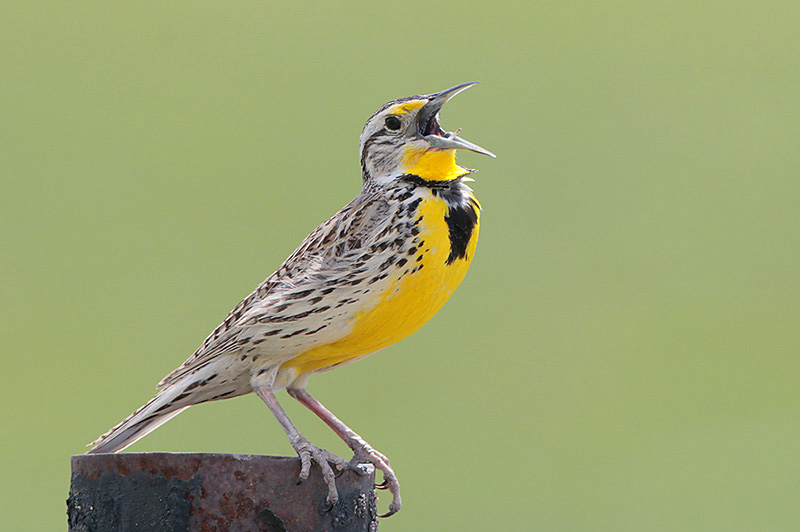
Nesting and Eggs
The female Western Meadowlark builds a rounded nest on the ground, often in a shallow depression. The nest is completed in 6 to 8 days and is built in sites with dense grass and other vegetation. It is not typically placed in cultivated fields.
The nest is made of grasses, strips of soft bark, and other soft vegetation and can be an open, shallow cup nest, or, more often, a dome-shaped nest that has an extended runway on the ground.
Western Meadowlark’s nest is typically 7 to 8 inches wide and has an inside depth of 2 to 3 inches.
This blackbird species lays a clutch of five, white eggs with brown, reddish, and purple speckling. One egg is laid per day, and eggs hatch after 14 days (a bit longer in cool weather).
The female feeds the young a variety of insects and places each food item directly into the mouth of the nestling. Males can bring food to the female to give to the young but the amount they bring varies. The baby birds leave the nest 10 to 12 days after hatching.
If the first nesting is successful, females immediately build a second nest in a different spot. The second nest is built in fewer days and tends to be less tidy than the first one.
If the first nest is not successful, females will renest until they raise young, sometimes trying several times in one season.
Current Situation
Western Meadowlarks live in a number of wide-open habitats from parts of southern British Columbia and central Canada south through much of the western and central USA to north-central Mexico.
Small populations also occur in large, open fields and other suitable habitats in Michigan, southern Ontario, and western New York state.
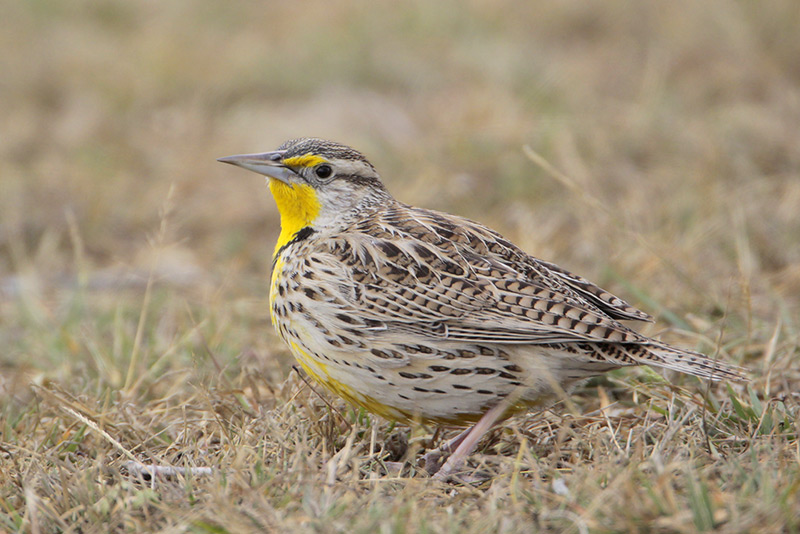
Populations that breed in Canada and parts of the northern USA migrate south as far as northern and central Mexico while birds in other parts of its range can make short-distance movements south or to lower elevations, or just not migrate at all.
This species is quite adaptable and does well in sparse, open grasslands, semi-arid habitats, cultivated fields that have some native grass, and even high mountain meadows.
They avoid areas with shrubs and dense woody vegetation and prefer habitats with grasses and low vegetation where there is an abundance of the crickets, beetles, and other insects it feeds on. During the winter, this species uses similar open grassland habitats as well as deserts.
The species is considered to be common and is not endangered. Populations can be affected by the conversion of grasslands to croplands and nests in cultivated areas are susceptible to being destroyed by spring tilling but overall, the Western Meadowlark is a commonly encountered species.
Facts
- The Western Meadowlark is a popular bird! It is the state bird of six different states where it is commonly seen and heard. These states are Kansas, Nebraska, North Dakota, Montana, Oregon, and Wyoming.
- Based on its different song, John James Audubon suggested that the Western Meadowlark was a separate species from the very similar Eastern Meadowlark. Since this species had been previously overlooked and considered the same as the Eastern Meadowlark, Audubon gave it the Latin species name of “neglecta”.
- In common with some other grassland bird species, when disturbed, the female will run on the ground before flying to try and hide the location of the nest.
- Since the Western Meadowlark destroys some crops by digging sprouting kernels out of the soil. They were considered a potential pest species until studies showed that eating insects is highly beneficial.
Similar Species
In much of its range, the rounded shape and black “V” marking on bright yellow breast make the Western Meadowlark an easy bird to identify. However, where it overlaps with the Eastern Meadowlark, this closely related and very similar species presents serious challenges for identification.
Chihuahuan Meadowlark
The Chihuahuan Meadowlark is a recently recognized species that is also extremely similar to the Western Meadowlark but has more white in the tail, and has a song more like that of the Eastern Meadowlark.
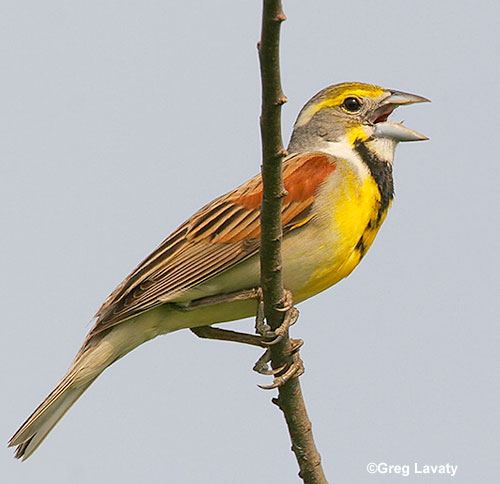
Dickcissel
The Dickcissel also has a black mark on a yellow breast and lives in some of the same areas as the Western Meadowlark.
It’s important to remember, that Dickcissels are much smaller, and they have a sparrow-like bill.
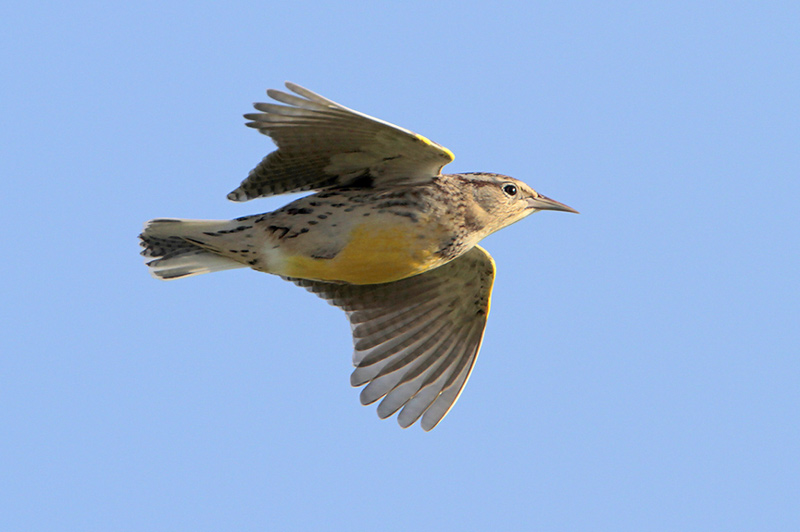
Eastern Meadowlark. Photograph © Greg Lavaty.
The Eastern Meadowlark looks almost exactly the same as the Western Meadowlark but it has a very different song, and the yellow on the throat of the Eastern does not reach the lower part of the face.
The biggest difference, however, is the fact that Eastern Meadowlarks live on the eastern side of North America, while Western Meadowlarks live on the western side.
Frequently Asked Questions
Where do Western Meadowlarks live?
Western Meadowlarks live in open grassy habitats in western and central Canada, and in much of the western and central USA. Some birds also live in suitable habitat in the Great Lakes region, and, in winter, they can occur east to Louisiana.
What is special about the Western Meadowlark?
The bright yellow colors and beautiful flute-like song of the Western Meadowlark make it a cheerful, popular bird in most parts of its range. Indeed, it is the state bird for seven states.
What is the difference between an Eastern and Western Meadowlark?
Although very similar, Eastern and Western Meadowlarks can be separated by their songs, and Western Meadowlarks tend to be paler above, have a bit more yellow on the lower part of the face, and have less white in the tail.
What does the Western Meadowlark symbolize?
The Western Meadowlark is a symbol of hope, cheer, happiness, and positivity.

